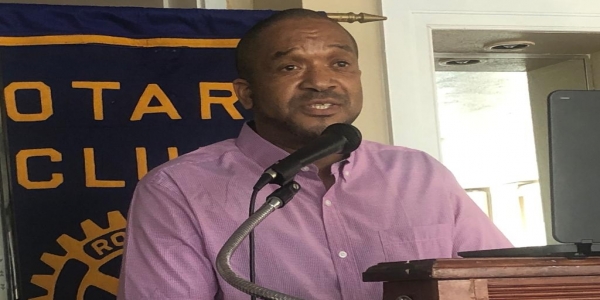It was Tuesday July 27, young Bermudian Tarik Smith delivered a powerful speech at the Hamilton Rotary Club luncheon and discussed a new water treatment system and how it could possibly be used and adapted to Bermuda.
Last summer, in collaboration with the Bermuda Institute of Ocean Sciences (BIOS) and the Ministry of Education’s Bermuda program, Mr. Smith, some Bermudian scientists and students, commenced the tank sediment management, or first flush, project.
According to Mr. Smith, the first flush diverter is not actually unique to Bermuda and is common in countries like Australia. Mr. Smith briefly explained how the mechanics of it work: there are two PVC pipes attached and a rubber ball.
“ If you have not had good rainfall for a few weeks, you can just imagine the amount of leaves, sediment, etc. that have accumulated on your roof. The first shower washes all of that debris directly into your tank,” he explained. “ What this first flush diverter does is diverts those first few [dirtier] gallons of water away from your tank. Once the chamber of dirty water is full, the cleaner water from your roof goes into your tank.”
According to Mr. Smith, the BUEI, Bermuda National Trust, Works and Engineering and BELCO have all shown some interest in collaborating with BIOS and the Bermuda Program with this project.
Before the diverter can become a reality, the team needs to research and analyze several things about Bermuda’s water quality, air quality and tank sediment quality. Of course, the project is not without its own set of challenges.
“One of the main challenges that we are trying to resolve is that there is very little data on sediment accumulation in tanks . . . what are the accumulation rates over a period of time and also sediment quality,” Mr. Smith said. “ What we hope to improve [in Bermuda] is the primary treatment system. The standard mechanism right now are tank gutter screens, also known as ‘ pineapples’, and we are looking at how that could be improved so that sediment can be greatly minimized before it even gets into the tank.”
Mr. Smith and the BIOS team need to figure out if the first flush diverter will even be able to minimize tank sediment accumulation and if the technology involved in the diverter could be adapted to Bermudian architecture.
“ We hope to address these challenges in the next phase of the project, but by the end of the summer, what we hope to do is complete the planning phase,” he said. “ [During that phase], we have to look at as many variables as possible–roof size, wind speed, rainfall, does the home have internal or external downpipes, etc.”
The planning phase for the project will hopefully be completed by September; the second phase, experimenting with the system using external downpipes, will last around 18 months and the third phase will be trying to retrofit the system to Bermuda.
“ If this first stage is successful, we would need to look at how to adapt this to Bermudian architecture,” Mr. Smith said. “ This project might be relatively expensive or it could be reasonably priced. We hope that this system could serve as an effective experimental tool so that we can collect water samples and can get a better understanding of what’s going on in our tank and the characteristics of it.”
As the project goes along, Mr. Smith and his team plan to conduct surveys asking participants about their daily water consumption habits and what they mainly use their tank water for.
————————————————————————Any content which is considered unsuitable, unlawful, or offensive, includes personal details, advertises or promotes products, services or websites, or repeats previous comments will be removed.
User comments posted on this website are solely the views and opinions of the comment writer and are not a representation of or reflection of the opinions of TNN or its staff.
TNN reserves the right to remove, edit or censor any comments.
TNN accepts no liability and will not be held accountable for the comments made by users.

